Farin G. Curves and Surfaces for CAGD. A Practical Guide
Подождите немного. Документ загружается.

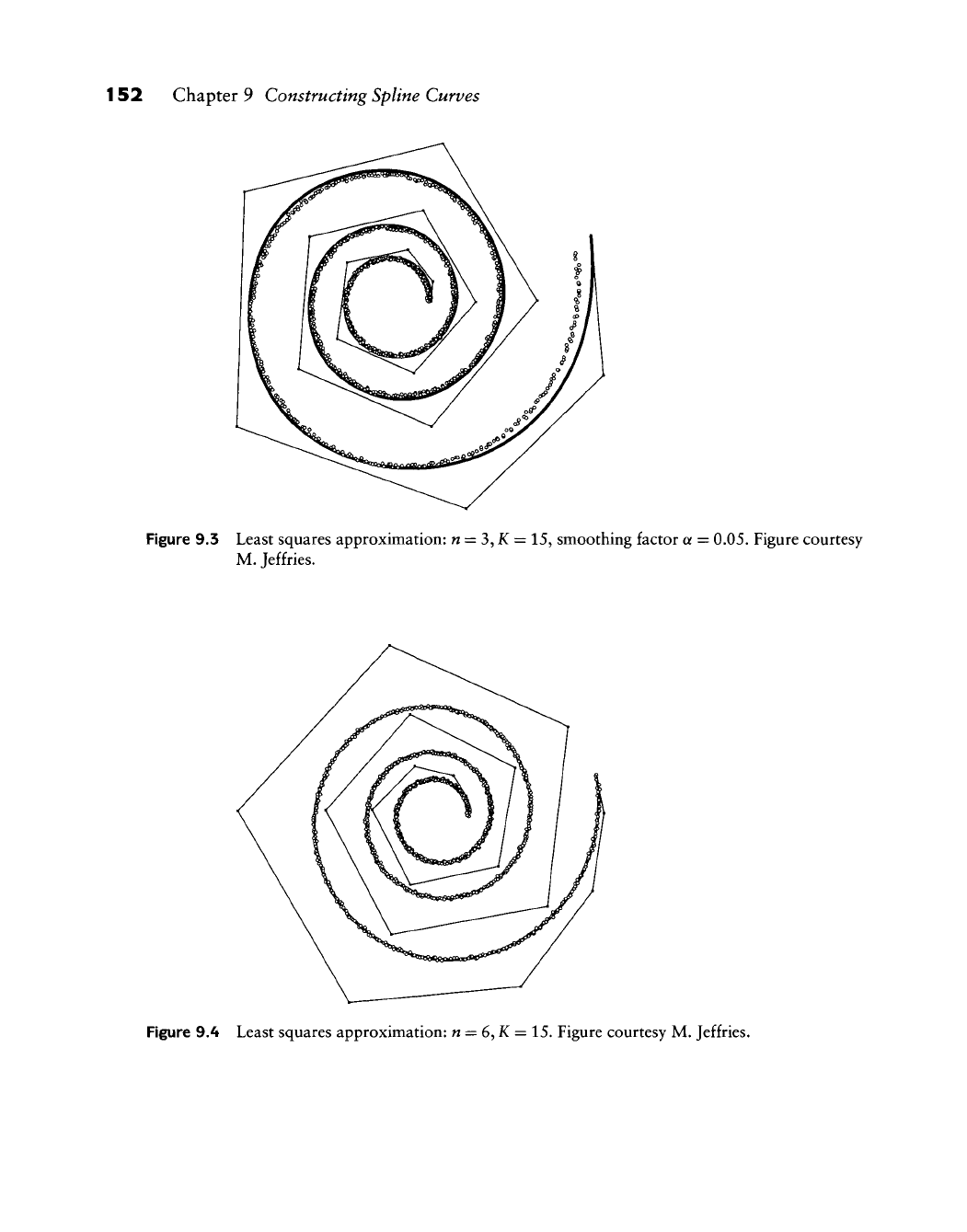
152 Chapter 9 Constructing Spline Curves
Figure 9.3 Least squares approximation:
w
= 3, K = 15, smoothing factor a = 0.05. Figure courtesy
M. Jeffries.
Figure 9.4 Least squares approximation: n = 6,K = 15. Figure courtesy M. Jeffries.

9.3 Modifying B-Spline Curves 153
Figure 9.5 Parameter correction: the connection of
p^
and piwj) is typically not perpendicular to the
tangent at
p(Wi).
A better value for
Wj
is found by projecting pi onto the tangent.
on the curve is not the closest point to
p^,
and thus ||p^
—
piWj)
\\
does not measure
the distance of p/ to the curve. This indicates that we could have chosen a better
data parameter value Wj corresponding to p/. We may improve our estimate for
Wj by finding the closest point to p^ on the computed curve and assigning its
parameter value Wj to
p^;
see Figure 9.5. We do this for all / and then recompute
the least squares curve with the new Wj, This process typically converges after
three or four iterations."* It was named parameter correction by
J.
Hoschek
[337],
[577].
The new parameter value Wi is found using a Newton iteration. We project
p^
onto the tangent at p(u^^), yielding a point q^. Then the ratio of the lengths
llq^
—
p(t6'/)||/||p(t^^/)|| is a measure for the adjustment of
Wi,
The actual Newton
iteration step looks like this:
^. = "^. + [p.-pK)]^^^. (9.8)
llpKOIr sk
In this equation, s^ denotes the arc length of the segment that Wi is in, that is,
Uj^
< Wi <
Uj^^i.
This length may safely (and cheaply) be overestimated by the
length of the Bezier polygon of the k}^ segment.
We finally note that (9.8) should not be used to compute the point on a curve
closest to an arbitrary point p/. It works only if
p^
is close to the curve, and if a
good estimate Wi is known for the closest point on the curve.
9.5 Modifying B-Spline Curves
The use of B-spline curves is often described like
this:
pick a control point, move it,
observe the shape of the resulting curve, and stop once a desired shape is obtained.
It is more intuitive, however, to let a user pick a point on the curve^ move it to a
4 In theory, more iterations should produce better fits. In practice, however, the fit often
deteriorates after more than four iterations.
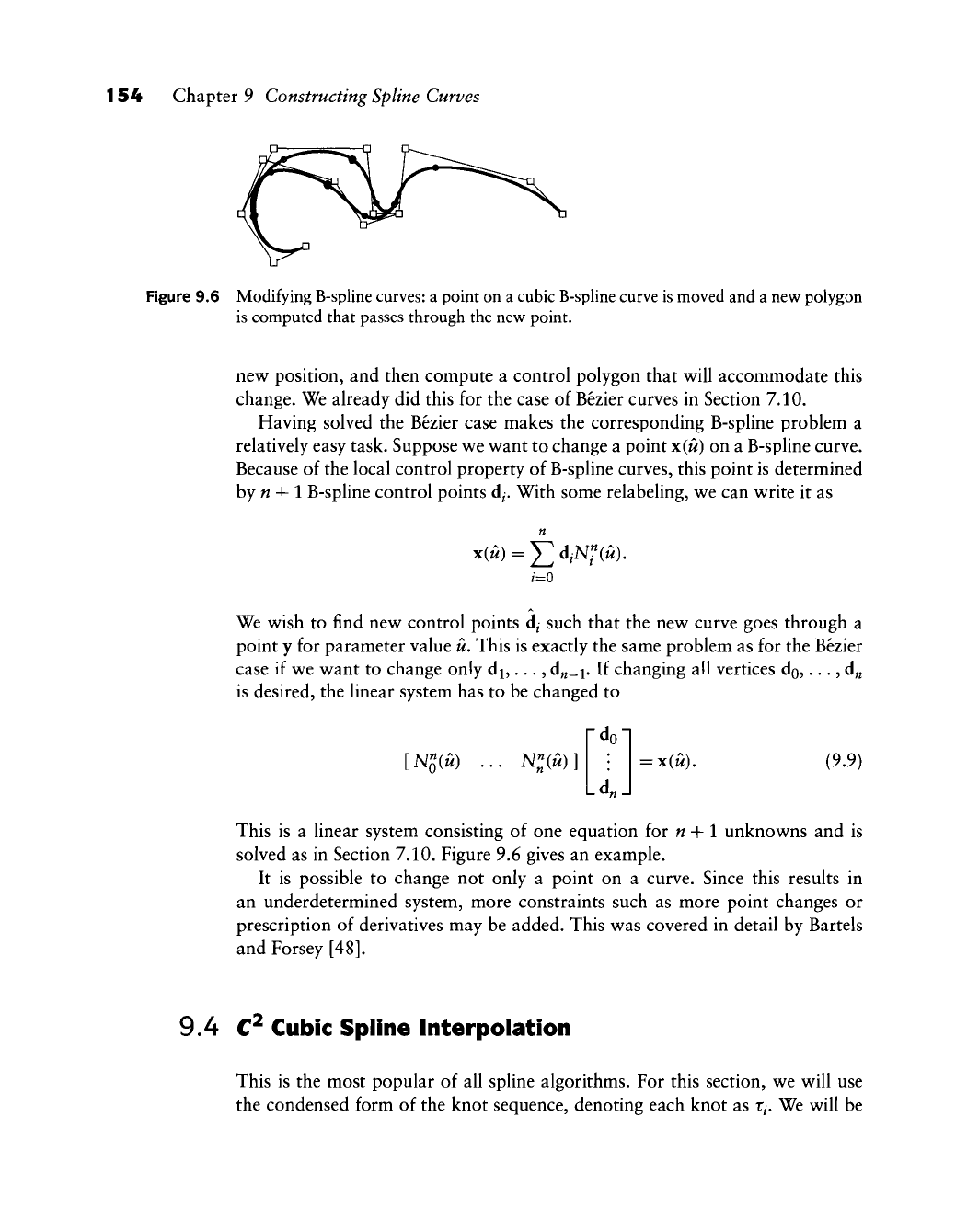
154 Chapter 9 Constructing Spline Curves
Figure 9.6 Modifying B-spline
curves:
a point on a cubic B-spline curve is moved and a new polygon
is computed that passes through the new point.
new position, and then compute a control polygon that will accommodate this
change. We already did this for the case of Bezier curves in Section 7.10.
Having solved the Bezier case makes the corresponding B-spline problem a
relatively easy task. Suppose we want to change a point x(u) on a B-spline curve.
Because of the local control property of B-spline curves, this point is determined
by n + 1 B-spline control points d^. With some relabeling, we can write it as
n
We wish to find new control points d^ such that the new curve goes through a
point y for parameter value u. This is exactly the same problem as for the Bezier
case if we want to change only
dj,...,
d„_i. If changing all vertices do,..., d„
is desired, the linear system has to be changed to
[N^(u)
N"„(u)
]
Ld„
= X(M). (9.9)
This is a linear system consisting of one equation for
w
+ 1 unknowns and is
solved as in Section 7.10. Figure 9.6 gives an example.
It is possible to change not only a point on a curve. Since this results in
an underdetermined system, more constraints such as more point changes or
prescription of derivatives may be added. This was covered in detail by Bartels
and Forsey [48].
9.4 C^ Cubic Spline Interpolation
This is the most popular of all spline algorithms. For this section, we will use
the condensed form of the knot sequence, denoting each knot as
Xj,
We will be

9.4 C^ Cubic Spline Interpolation 155
do
=
Po
XQ X^ Xg
Figure 9.7 Cubic spline interpolation: the case of clamped end conditions with six intervals.
dealing only with knot sequences that are simple (/x^ = 1) except for the end knots
that are of multiplicity three:
/XQ
= 3,
/Xj^;
= 3.
The problem statement is as follows:
Given: A set of data points Po?
• • • ?
Px ^nd a knot sequence
TQ,
...,
T]^
and a
multiplicity vector 3,1,1,...,1,1,3.
Find: A set of B-spline control points do,..., d^^ with L = K -\-2 such that the
resulting C^ piecewise cubic curve x(u) satisfies
x(r,) =
p,-;
/ =
0,...,K.
(9.10)
Consult Figure 9.7 for an example of the numbering scheme.
As it turns out, the preceding problem is ill posed: the number of unknowns
is K + 3, whereas the number of given data points is K + 1. This is an underde-
termined problem; two more conditions are needed in order to have a uniquely
solvable problem. We will discuss several possibilities for this; to begin with, we
consider clamped end conditions,
A clamped end condition corresponds to the prescription of two derivatives
x(ro) and x(rx). They are given by
3 3
x(ro) = [di - do], xCr^) =
[d^^
-
d^-i].
Ti - to tx - Tj^-\
The geometry of this interpolation problem is illustrated in Figure 9.7
Because of the triple end knots, we immediately have
do = Po and di^ = px;
this takes care of equations #0 and #X of (9.10). We will not use these in setting
up our linear system.
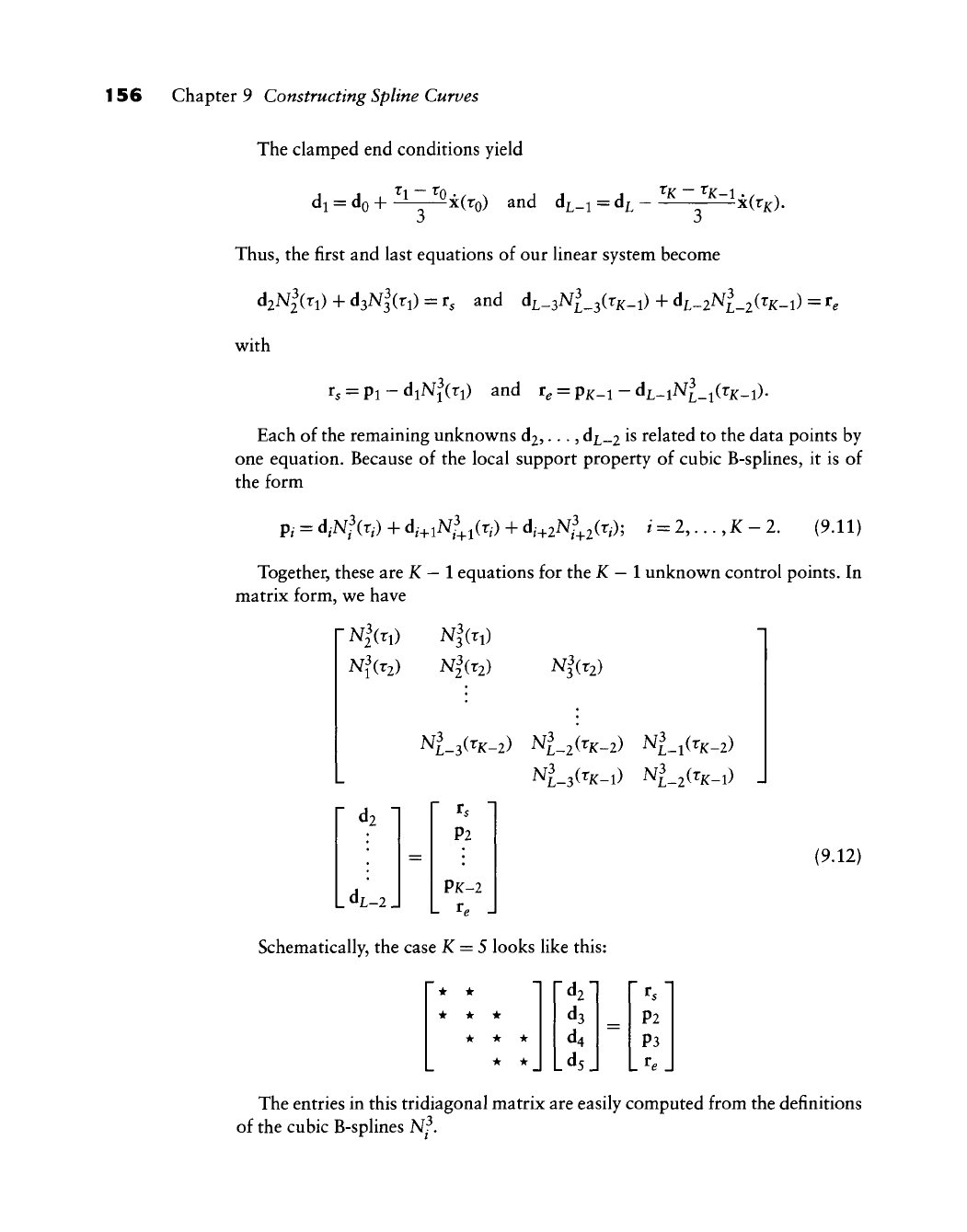
156 Chapter 9 Constructing Spline Curves
The clamped end conditions yield
di = do + ^^^x(ro) and d,^_i = d^, - ^^^^^xCr^).
Thus,
the first and last equations of our linear system become
d2N|(ri) + daN^Cri) = r, and ^L-?>^1-2>^-^K-\) + ^L-l^l-ii^K-i) =
^e
with
rs = Pi-diN^(ri) and r^ =
PK-1
- dL-iN^_i(rK-i).
Each of the remaining unknowns
d25...,
dj^_2 is related to the data points by
one equation. Because of the local support property of cubic B-splines, it is of
the form
p,
= d,N3(r,) + d,+iN^i(r,) +
Ai^rn]^-^{x>);
i = 2,...,K-2. (9.11)
Together, these are iC
—
1 equations for the K
—
1 unknown control points. In
matrix form, we have
N|(T2)
Ni_3(rK_2) Ni_2(TK_2) H-l(-'K-2)
L^L-2
P2
PK-2
L r^
(9.12)
Schematically, the case K = 5 looks like this:
* •
• • •
• • •
• •
d2
ds
d4
Ids]
ts
P2
P3
.^e]
The entries in this tridiagonal matrix are easily computed from the definitions
of the cubic B-splines Nf,
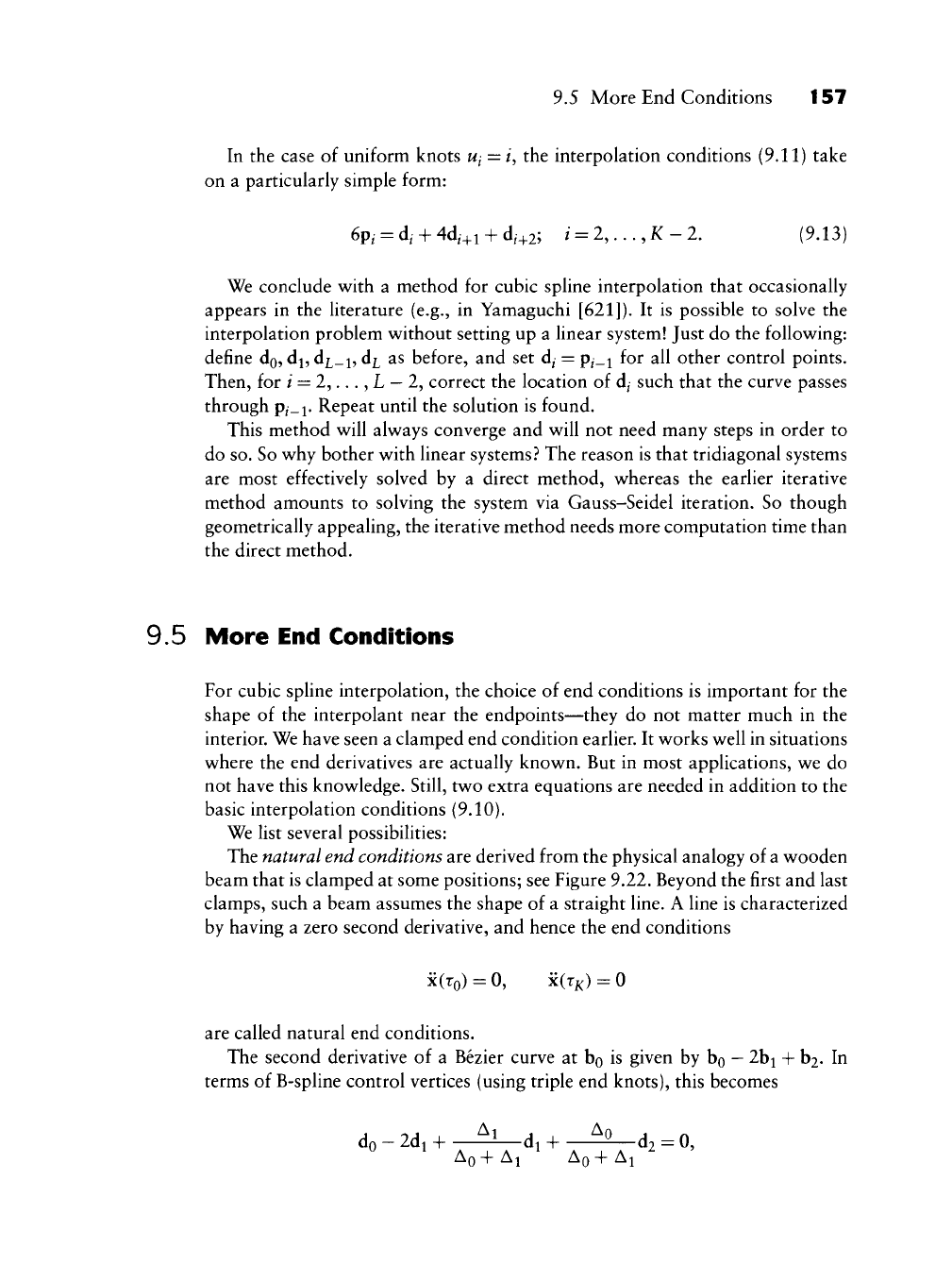
9.5 More End Conditions 157
In the case of uniform knots
Ui
= /, the interpolation conditions (9.11) take
on a particularly simple form:
6p,-
= d, + 4d,+i + d,+2; / =
2,...,
X - 2. (9.13)
We conclude with a method for cubic spline interpolation that occasionally
appears in the literature (e.g., in Yamaguchi [621]). It is possible to solve the
interpolation problem without setting up a linear system! Just do the following:
define do, d^, dj^_i, d^^ as before, and set d/ = p/_i for all other control points.
Then, for / =
2,...,
L
—
2, correct the location of d^ such that the curve passes
through p^_i. Repeat until the solution is found.
This method will always converge and will not need many steps in order to
do so. So why bother with linear systems? The reason is that tridiagonal systems
are most effectively solved by a direct method, whereas the earlier iterative
method amounts to solving the system via Gauss-Seidel iteration. So though
geometrically appealing, the iterative method needs more computation time than
the direct method.
9.5 More End Conditions
For cubic spline interpolation, the choice of end conditions is important for the
shape of the interpolant near the endpoints—they do not matter much in the
interior. We have seen a clamped end condition earlier. It works well in situations
where the end derivatives are actually known. But in most applications, we do
not have this knowledge. Still, two extra equations are needed in addition to the
basic interpolation conditions (9.10).
We list several possibilities:
The natural end conditions are derived from the physical analogy of a wooden
beam that is clamped at some positions; see Figure 9.22. Beyond the first and last
clamps, such a beam assumes the shape of a straight line. A line is characterized
by having a zero second derivative, and hence the end conditions
x(ro) = 0, x(rx) = 0
are called natural end conditions.
The second derivative of a Bezier curve at bo is given by bo
—
2bi + b2. In
terms of B-spline control vertices (using triple end knots), this becomes
do
- 2di + -4^di + -4^d2 = 0,
AA+AI An + A,
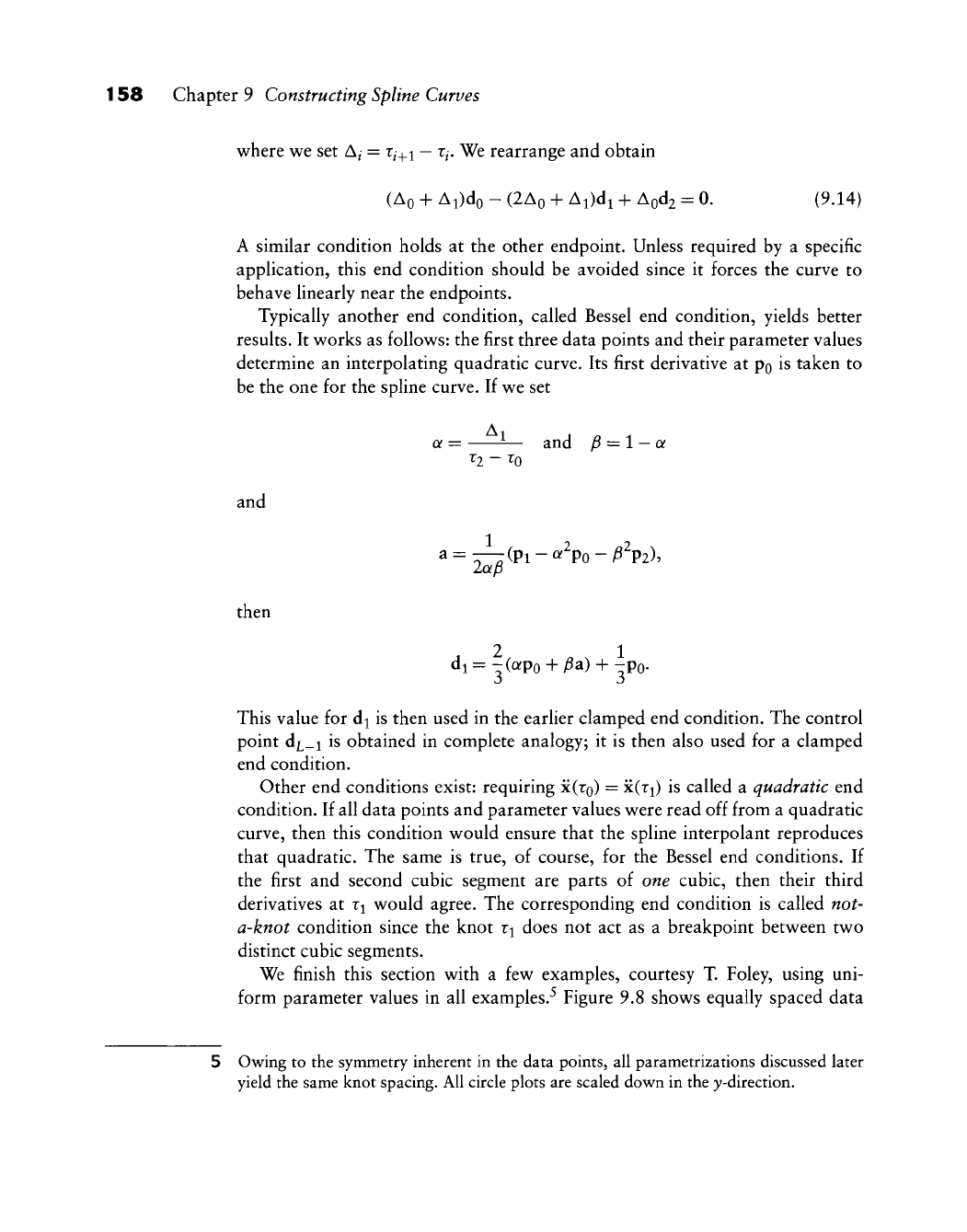
158 Chapter 9 Constructing Spline Curves
where we set A^ = r^+i
—
r^ We rearrange and obtain
(Ao + Ai)do - (2Ao + Ai)di + Aod2 = 0. (9.14)
A similar condition holds at the other endpoint. Unless required by a specific
application, this end condition should be avoided since it forces the curve to
behave linearly near the endpoints.
Typically another end condition, called Bessel end condition, yields better
results. It works as follows: the first three data points and their parameter values
determine an interpolating quadratic curve. Its first derivative at po is taken to
be the one for the spline curve. If we set
a = — and
j6
=
1
—
of
^2 -
"^0
and
1
lap
then
2 1
di=-(apo + ^a) + -po.
This value for dj is then used in the earlier clamped end condition. The control
point d£^_i is obtained in complete analogy; it is then also used for a clamped
end condition.
Other end conditions exist: requiring x(ro) = x(ri) is called a quadratic end
condition. If all data points and parameter values were read off from a quadratic
curve, then this condition would ensure that the spline interpolant reproduces
that quadratic. The same is true, of course, for the Bessel end conditions. If
the first and second cubic segment are parts of one cubic, then their third
derivatives at X\ would agree. The corresponding end condition is called not-
a-knot condition since the knot r^ does not act as a breakpoint between two
distinct cubic segments.
We finish this section with a few examples, courtesy T. Foley, using uni-
form parameter values in all examples.^ Figure 9.8 shows equally spaced data
5 Owing to the symmetry inherent in the data points, all parametrizations discussed later
yield the same knot spacing. All circle plots are scaled down in the }/-direction.
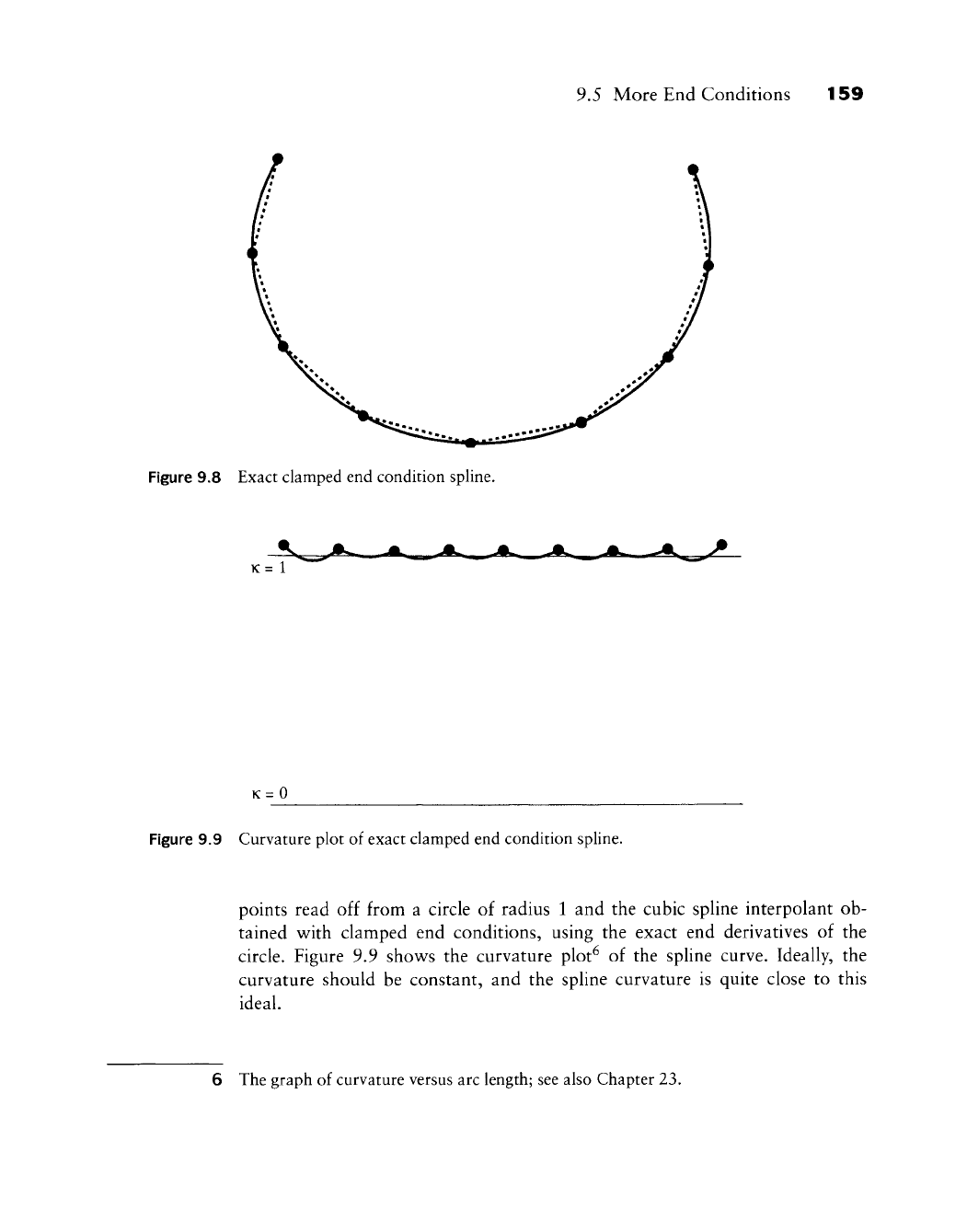
9.5 More End Conditions
159
Figure 9.8 Exact clamped end condition spline.
K=l
K=0
Figure 9.9 Curvature plot of exact clamped end condition spline.
points read off from a circle of radius 1 and the cubic spline interpolant ob-
tained with clamped end conditions, using the exact end derivatives of the
circle. Figure 9.9 show^s the curvature plot^ of the spline curve. Ideally, the
curvature should be constant, and the spline curvature is quite close to this
ideal.
6 The graph of curvature versus arc length; see also Chapter 23.
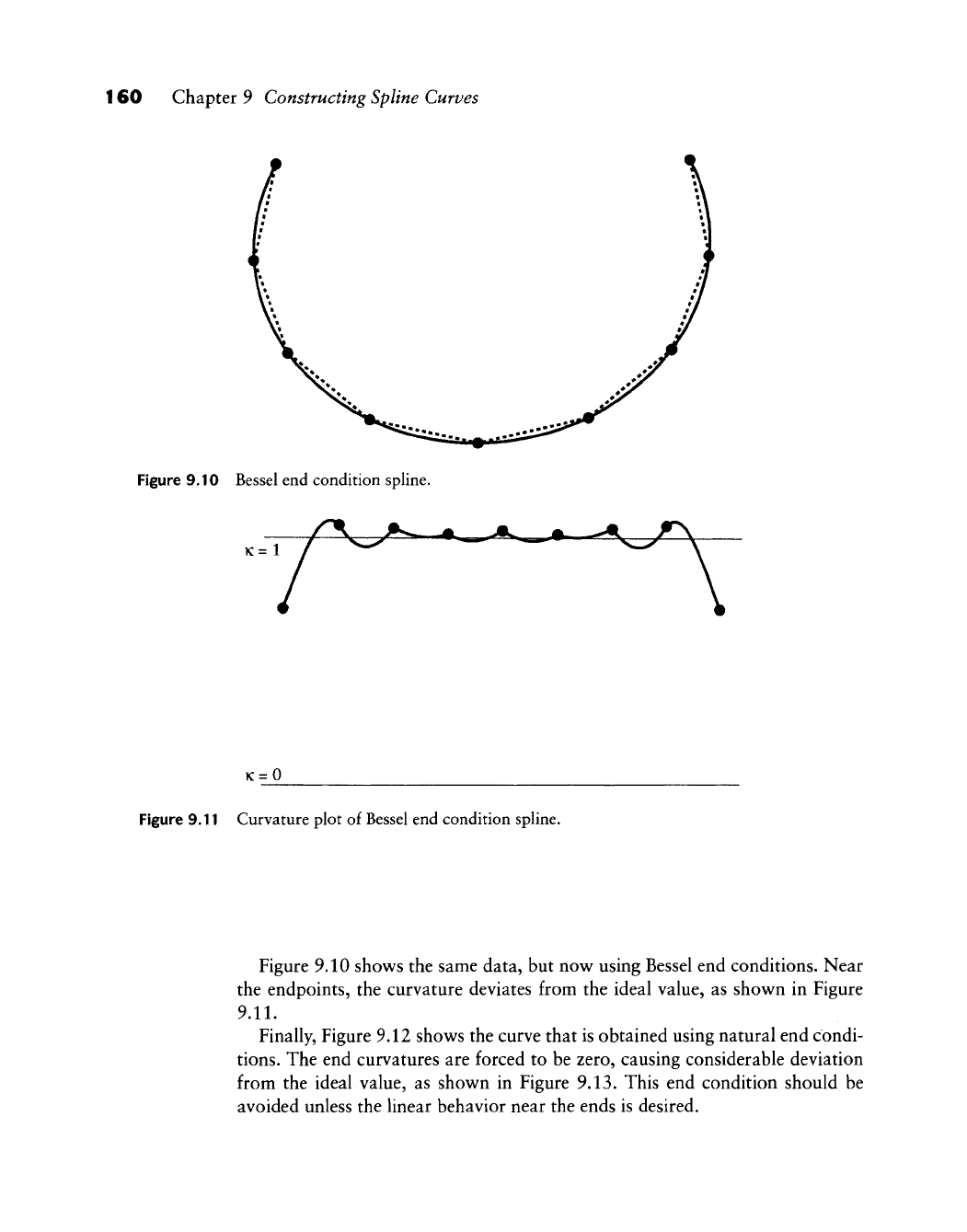
160 Chapter 9 Constructing Spline Curves
Figure 9.10 Bessel end condition spline.
K=l
K=0
Figure 9.11 Curvature plot of Bessel end condition spline.
Figure 9.10 shows the same data, but now using Bessel end conditions. Near
the endpoints, the curvature deviates from the ideal value, as shown in Figure
9.11.
Finally, Figure 9.12 shows the curve that is obtained using natural end condi-
tions.
The end curvatures are forced to be zero, causing considerable deviation
from the ideal value, as shown in Figure 9.13. This end condition should be
avoided unless the linear behavior near the ends is desired.
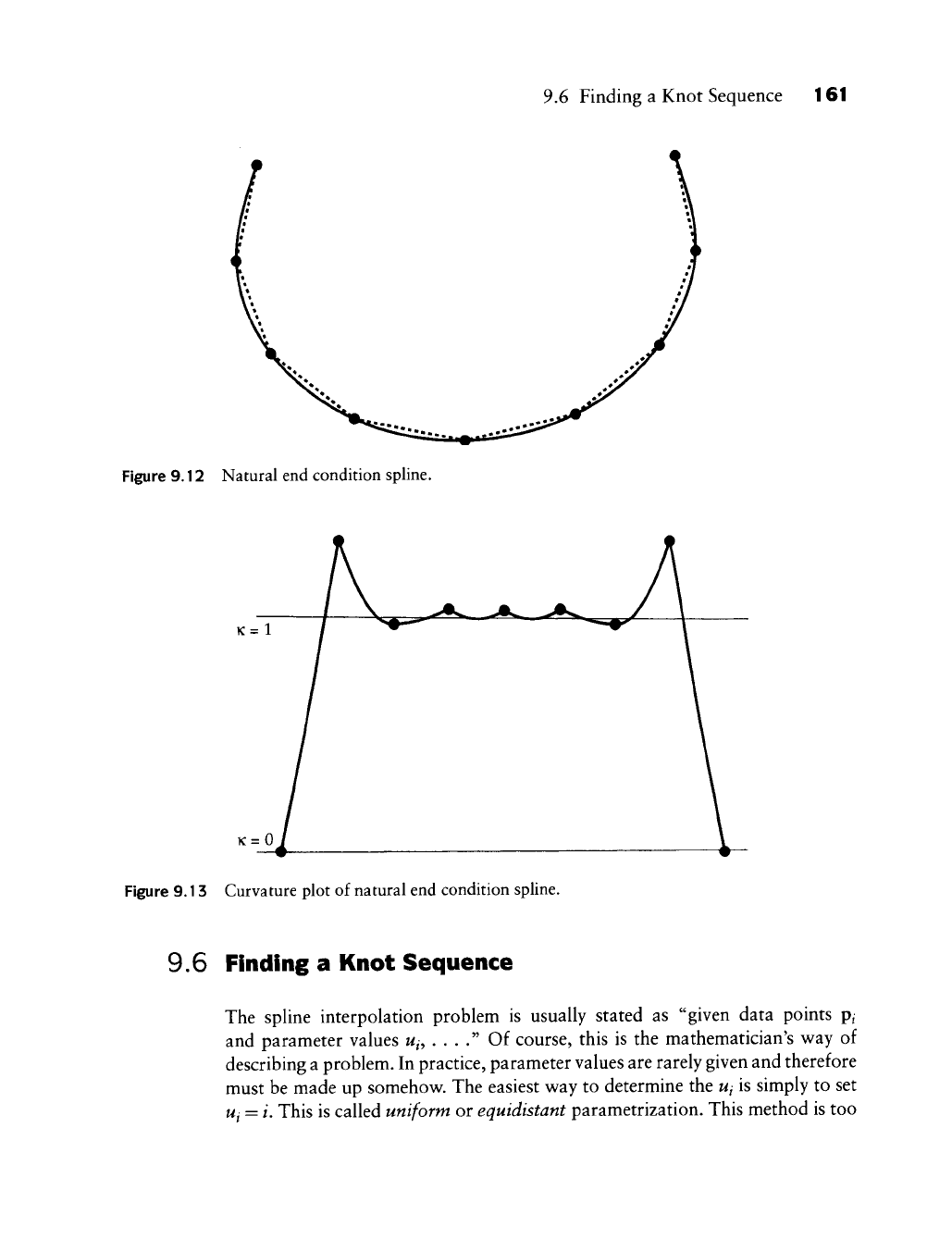
9.6 Finding a Knot Sequence 161
Figure 9.12 Natural end condition spline.
K=l
K=0
Figure 9.13 Curvature plot of natural end condition spline.
9.6 Finding a Knot Sequence
The spline interpolation problem is usually stated as "given data points p^
and parameter values w^, . ..." Of course, this is the mathematician's way of
describing a problem. In practice, parameter values are rarely given and therefore
must be made up somehow. The easiest way to determine the ui is simply to set
Ui
= i. This is called uniform or equidistant parametrization. This method is too
